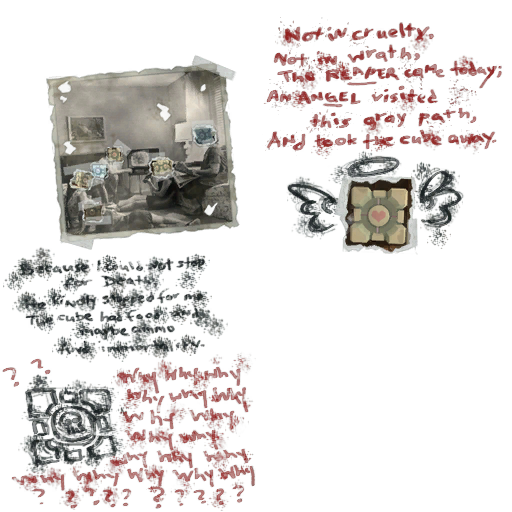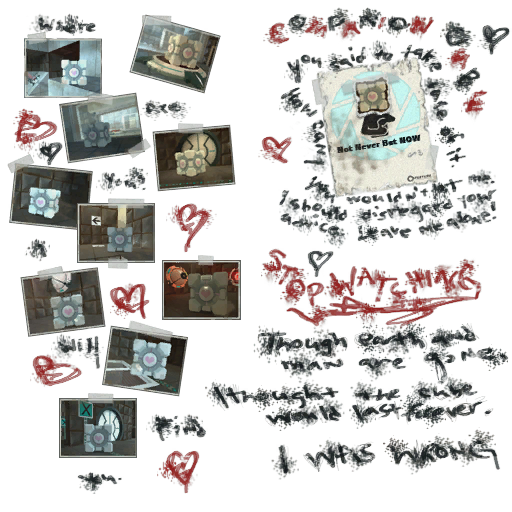At
first glance, Portal might seem like
nothing more than a unique, quirky puzzler, but the quick romp through Aperture
Laboratories holds far more than just crates, buttons, and inter-dimensional holes.
Within only about only three or so hours of content, Valve weaves an efficient yet
substantial narrative, as well as showcasing incredible game design. This story
of an artificial intelligence and a silent protagonist might seem shallow, when
in reality many elements display deeper and more intricate content that what
appears on the surface. Just like any other form of media, Portal conveys themes and social commentary, albeit more subtly but
still effectively, keeping with Marcuse’s observation that, “entertainment may
be the most effective mode of learning,” (Chapter 3). The most apparent of
these themes is that of a Marcuse-ian, overt control of humanity by technology,
which is expressed not only through the game’s narrative, but also its
gameplay.
The
most obvious instance of this is the interaction between Chell and GLaDOS. The
AI is greatly authoritarian, and commands Chell constantly to continue testing,
all the while promising her “cake and grief counseling” when she is complete. The
cake, if nothing else, represents the final completion of the hellish testing
process, an imposed need that Chell develops due to the constant mentioning of
it by GLaDOS. Of course, the cake is indeed found to be a “lie”, a false need
that is instilled for nothing more than providing a motivating source for test
subjects to finish the course, fulfilling GLaDOS’ seemingly endless pleasure in
conducting “science,” or murder of test subjects. GLaDOS here is representing
the social interests of the media by creating these false needs and hopes, “perpetuating
toil, aggressiveness, misery, and injustice,”(Chapter 1) Furthermore, GLaDOS
herself can be seen as an example of Marcuse’s fundamental contradiction
regarding the creation of machinery. She was created for the sole purpose of
conducting human testing, as the researchers of Aperture Laboratories did not
want to waste time with such a rudimentary task. She then goes on to flood the
entire Enrichment Center with neurotoxins despite the many personality cores
that were installed to attempt to keep her from becoming homicidal. Although
the researchers were freed from the task of testing, they did not consider the
consequences of creating the AI, and were killed by the very materials that
they had entrusted to the machine.
Even
the game’s most important gameplay element, the portal gun, represents aspects
of technology controlling humanity. Although it grants Chell greater freedom of
movement and increased options for completing additional tests, it is a
catalyst for nothing more than her increased misery. The more the GLaDOS
reveals concerning the device, such as changing the course of deadly energy balls
in Chamber 7 or the conservation of momentum
and velocity through portals in Chamber 10, the more danger that Chell is
exposed to, providing an example of Marcuse’s technological reality, which, “extend[s]
liberty while intensifying domination,” (Chapter 3). The portal gun slowly
leading Chell to her demise is further supported by GLaDOS’ constant remarks
that her tests are becoming more and more dangerous, as well as her final
attempt to kill Chell at the end of Chamber 19 by dumping her in a fiery pit.
Even as Chell is attempting to escape, the increasing utility of the portal gun
continues to put her into increasingly deadly situations, as well as cause GLaDOS
to send more turrets and lethal threats.
Another
narrative example of this control by technology can be seen in the remains of a
seemingly previous test subject. Found first in Chamber 16, these dens are littered
with graffiti, speaking towards GLaDOS’ true intentions and warning the player
over and over that “the cake is a lie”. The most important of the remains are
the endless obsessions that the he or she has with the Weighted Companion Cube,
as can be seen the provided images of his or her scrawling. Although the cube
is meant to be nothing more than tool for a subject to complete Chamber 17
with, it is presented as a resource to be treasured, which the crazed previous
subject had obviously taken to heart. The writings on the wall are meant to be
jarring to the player, and are an example of the alienation effect that is
meant to reveal that the insanity of test subjects is not something that is
commonplace, and it is Chell retaining her sanity that is in fact rare. The control
in which GLaDOS exerts on her subjects with nothing more than a simple cube is
meant to be ridiculous in such a way that it shows just how effective her
testing is in controlling every aspect of a subject’s being. Although the
examples of control within the game are far more pronounced than that which the
media and society exerts in real life, the story of GLaDOS and Chell is still a
“huge success” in exemplifying the control that technology has over humanity.
-------------------------------------------------------------------------------------------------------


1 comment:
The thing that most distinguishes this essay this week is your explicit focus in the thesis on gameplay. Sometimes when I get essays on popular music, they only ever say anything about the lyrics, ignoring the music itself. There is a danger of doing the same with video games, which fortunately you're explicitly trying to evade.
The 2nd paragraph is good and dense, although it doesn't, oddly, really engage with gameplay. The analysis of Marcuse is good and the analysis of Portal is fine, but it's odd that you don't address the comic/satiric aspects (are there any other aspects, really?) of the cake. This is funny, over the top material, and should ideally be analyzed as such.
Re: the third paragraph - It's hard not to agree, and yet we/Chell use the portal gun to escape being baked. How does that fit? Is that part of a "higher design" by GLaDOS's own designers? Is she herself, therefore, in a kind of maze?
I like the discussion of the companion cube, with two qualifications. First, at some point we need to treat humor as humor, although it has its serious dimension. Second, I'd like to see this material related to the role that the companion cube plays within the gameplay...
Overall: This was a good analysis, although somewhat less focused on gameplay than I expected (I'd like to see more, obviously). I still protest the lack of concern with the satiric dimensions of the game (which are clearly still very compatible with your vision).
Nice screenshots!
Post a Comment